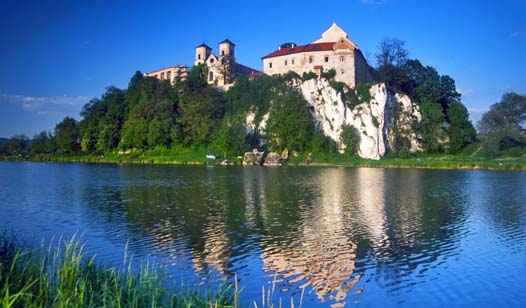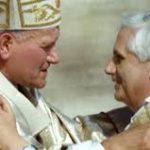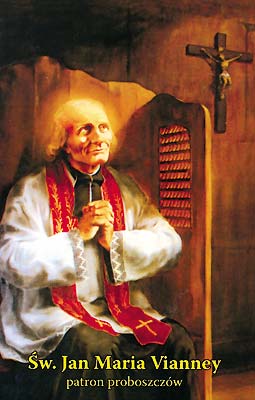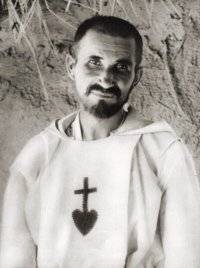 St.. Andrzej Świerad and Benedict
St.. Andrzej Świerad and Benedict
Others followed
In the northern part of Nowy Sącz, tam, where the Dunajec is transformed into the Czchowskie Lake, there is the village of Tropie. In it it is on a steep rock, on the very shore of the lake, there is an ancient Romanesque church from the 11th century. In that same church, in the main altar there is an old painting of the patron saints of this temple : st. Andrzej Świerad and St.. Benedict. A few hundred meters away, in the forest, on the hill there is a small chapel built on a concave rock. This is the hermitage of St.. Świerad. There is a spring next to it in the forest, which the people respect very much, and he attributes its healing properties to the water.
A thousand years ago, Andrzej Świerad came to this area and settled here. With your hermit life, full of mortification and prayer, he wanted to attract his countrymen to the Christian faith. Same place, which he chose, it made his task easier. Admittedly, the area was wild, not yet touched by the hand of man, but full of charm and raw beauty. Being in such surroundings, it was easier for Świerad to pray and come closer to God, whose greatness and beauty he saw as if reflected in the beauty of the surrounding landscape.
The details of this hermit's childhood are lost in the darkness of history. Chroniclers say, that he was born near Opatowiec on the Vistula River, from parents already baptized, from a knightly family. His father's name was Marek, and Agnieszka's mother. Świerad receives a good upbringing at his family home and attends a monastery school, perhaps in Moravia, where Christianity had previously adopted. Seeing, how saintly and godly monks live in this monastery, he caught fire and he went to hermit-missionary life. After all, the Polish land was still fallow, and Christianity has only just begun to take its first steps. So he returns to his family home, but soon she leaves him, to be in the forest, near Opatowiec, to set up a hermitage. Even today, the inhabitants of those areas show the source "Zaradeusz", from which he drew water, while he lived in this hermitage. Later though, when the forest was depleted, the saint Hermit Opatowiec leaves. It crosses the Vistula River and along the Dunajec River it advances upstream, until he arrives at Tropia, where he is captivated by the beauty of the area. Here he finds a hollow cave in the forest on the Dunajec River, which he chooses for his dwelling and, as is the custom of his contemporary hermits, he prays a lot, performs night watches, works physically, he grieves himself. He doesn't remove himself from people, but rather he draws near to them and proclaims Christ to them. It does so simply and clearly, with words and an example of life, to be understood by the inhabitants of this area, who are just taking the first steps in the "new faith". A lot of water will flow in the Dunajec River, before that faith penetrates the depths of their souls, it will displace old pagan mores and slowly shape them. Świerad will deserve a great contribution to this, who became a living example for those around him, how should Christ be served in daily life.
This holy hermit doesn't stop there. Connects with itinerant missionaries. He visits monasteries available to him, where he takes part in the Holy Mass, confesses, communicates. He also does not break his connection with his family or with the eminent personalities of those times he knew. They will now often seek his advice and invite him to their place. There is evidence, that he knew Stefan personally, king of Hungary, later canonized saint. Therefore, after Świerad's death, the Hungarians will try, that he would be canonized together with Stefan and his son Emeryk.
After years of staying at the hermitage in Tropie, Świerad crossed the Carpathians and entered the monastery of St.. Hippolytus in the village of Zobor near Nitra. There he was given the religious name Andrzej. There he also led the life of a hermit in the cave, which they show today. From time to time, Świerad-Andrzej paid a visit to his monastery, and the fame of his holiness grew more and more and aroused universal admiration. Young Maurus testifies to this, student of the monastery school, which forty years later, already being a bishop, wrote these words in his curriculum vitae : "I have seen a holy and just man". Throughout his life, Maurus zealously spread the cult of his admired holy hermit.
The time has come, when the man of God left this world and received a reward from the Lord. Death for him was a liberation from the bondage of the flesh. It happened in a year 1007. The saint was then years old 76. When the brothers were preparing him for the funeral, they saw a sharp chain on his hips, which grew into flesh. Such penances and mortifications prepared the glory in heaven for Saint Świerad. The words of St.. Paul : “I gave it up and thought it was rubbish, that I may gain Christ and be in Him " (Flp 3, 8-9).
The second holy hermit, Benedict, in the secular state his name was Stosław. He was born in Budzisław near Gniezno and was the son of knight Zbylut-Jędrzej and Bogumiła-Anna, belonging to a distinguished family. At first he was an itinerant hermit missionary. When he met Świerad, captivated by his holiness stays with him. He becomes his spiritual student. She imitates his life and faithfully accompanies him in all his missionary activities. He also lives with him in a hermitage in Tropie. Here on the Dunajec River, in southern Poland, soon others join the two hermits. They settle all over the neighborhood. And so in the hermitage near Tęgoborze, on the mountain still called by his name, Just the hermit was staying, in the secular state Skarbimierz. And in the hermitage in Iwkowa, Urban lived and repented, once called in the world Krzesimierz.
When, after years in Tropie, Świerad goes to the Carpathians, to the land of Nitra, Benedict accompanies him faithfully and is with him until his death. Having buried their spiritual master, Benedict became a living chronicle of the Saint, telling his deeds and miracles, which he witnessed. Three years after Świerad's death, he is martyred by the robbers.
The lives and deeds of both holy men of God moved the faithful to invoke them as intermediaries before God. A synod convened in Hungary by the later St.. Władysław, King of Hungary, with the consent of Pope Gregory VII in 1083 he brought them to the altars. They are now patronizing two dioceses : Tarnowska in Poland and Nitra in Slovakia.
Millennium Celebrations, which in 1966 r. took place in Tropie, revived the honor of Świerad and Benedict, which has survived to our times for many centuries. For those living today, both saints are an example, how to live by faith, love of God and neighbor.
Also worth reading: Benedict XVI – curriculum vitae








